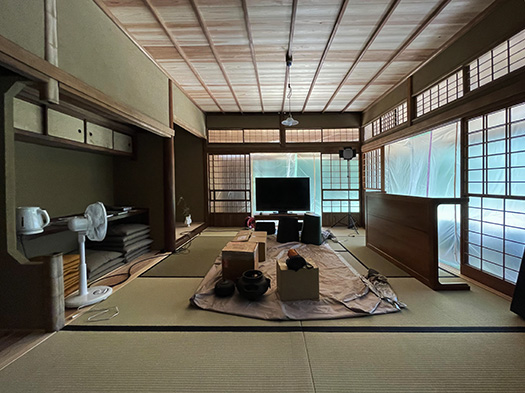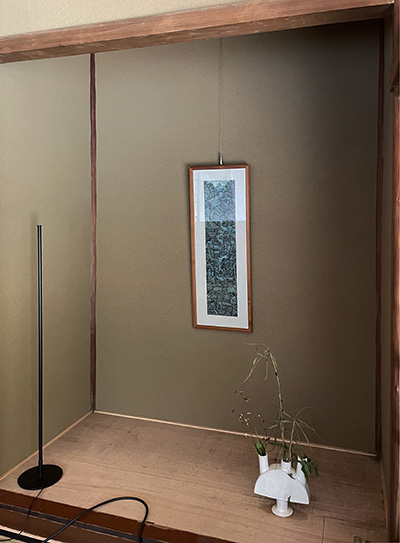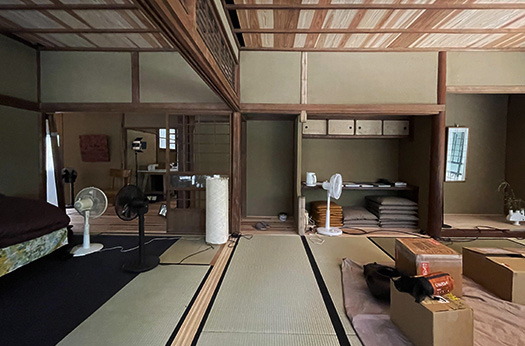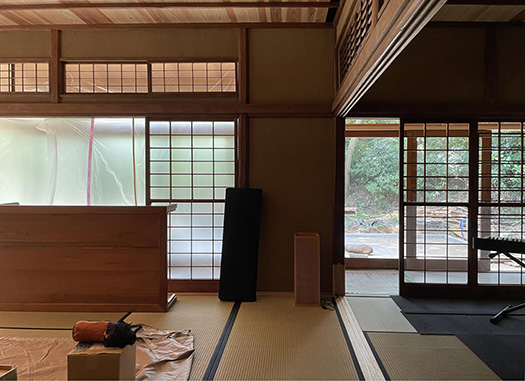


この建物を再生利用したいと丸谷さんが考えただけあって
その構成素材の素性には和風建築としての格調が感じられます。
写真の空間は水盤に面したメイン居室の座敷2間。
ふすま建具で仕切られたものが開放されみごとな広間が広がる。
周囲の植栽・森の様子らが水盤をも演出装置として座の目線で楽しめる。
いかにも日本の伝統的高級住宅手法が全開している。
近接した自然を建物の内部にまで引き込むという日本人の発想を感じる。
春夏秋の3シーズンで周囲の自然と完全に一体化することを
花鳥風月思想、あるいは老荘思想として和の精神性と感じ続けていた。
「冬さえガマンすれば・・・」という四季への感覚。
開口部の緩衝装置としては障子と非常時用の雨戸程度で、
あくまでも眺望最優先の思想になる。
なので「家は庭があってはじめて家庭なのだ」みたいな生活哲学になる。
一方北海道住宅は冬には大量の積雪で庭木が雪でやられる不安が大きく
庭のキャンセル率が高くなっている。
一生懸命に庭仕事に努力しても、楽しめる時間はせいぜい半年。
北海道人にしてみれば豊かな大自然との対話は1方向からの眺望で十分で
外にちょっと出ればいやでも視線に飛び込んでくると考える。
大空と自然との対話は1方向の窓からもダイナミックに感じられる・・・。
もし大開口空間を作るときには「開く」と「閉じる」の対話作業。
寒冷地での熱環境的には2面の開口部が全開している状態は難しい。
日射取得効果と3重ガラスの性能で熱環境のバランスを考えることになる。
和の眺望空間は高断熱住宅を見続けている人間としては、飛躍した空間。
浮輪寮は建築の用途が「IDEA CENTER」ということで非住宅。
発想の自由度を第1に考えた建物として古建築の美感を受容したのでしょう。
こういう開放型空間でやさしい気候環境と対話したいと考えるのは自然。
北国人としてはこういう自然との対話志向性を理解しつつ、
気候風土と調和させるにはどうしたらいいかと知恵と工夫で立ち向かう。
そういうハンデキャップレースはそれなりに楽しい(笑)。
「拡張された花鳥風月」をどうやったら北海道は獲得できるか、
こういうテーマ設定はなかなか無限に蠱惑的かと。

こういうあたりの居住環境性について
東京町田の環境の中で、春夏秋の季節感と冬対応をどうされているのか、
どんな試行をされているのか、機会を見てぜひ取材したいと思っています。
ただやはりわたし的には日本人なので、蒸暑の夏などに
こういう空間美のなかで感じる花鳥風月に憧憬する部分は大きいです。
失って知る、民俗記憶のなかのいごこちの良さみたいなものか。
English version
A Japanese-style large opening and Hokkaido-style blurring (laughs) Exploration of Tokyo Machida “Ukirinryo” – 4
A space in which the Japanese concept of “Kacho-fu-getsu” (flowers, birds, winds, and the moon) is abstracted. Hokkaido people, who are not able to perceive the same things in the same way, are oriented toward the “expansion of Kacho-fu-getsu” by force. …
Mr. Marutani wanted to revitalize this building.
The materials used in its construction are of a Japanese architectural quality.
The space in the photo is the two tatami rooms of the main living room facing the water table.
The room is divided by fusuma fittings, which are then opened to reveal a magnificent spacious room.
The surrounding plants and forest can be enjoyed from the viewpoint of the water table as well.
This is a traditional Japanese luxury residence in all its glory.
The Japanese concept of drawing nature into the interior of the building is very much in evidence.
The three seasons of spring, summer, and fall are to be completely integrated with the surrounding nature.
I have always felt that the idea of “Kacho-Fu-Getsu” or “Lao-Zhuang” is the spirituality of harmony.
The sense of the four seasons, “If only we could endure winter….
The only buffer devices at the openings are shoji screens and emergency storm shutters.
The view is the highest priority.
Therefore, the philosophy of life is that “a house is a home only if it has a garden.
On the other hand, in Hokkaido, there is a great deal of snowfall in winter, and there is great concern that the garden trees will be damaged by the snow, resulting in a high rate of garden cancellations.
The cancellation rate of the garden is high.
Even if you work hard on your garden, you can only enjoy it for half a year at most.
For Hokkaido residents, a view from one direction is enough to interact with the abundant nature.
If you go outside for a moment, it will jump into your line of sight.
The sky and nature can be dynamically felt even from a window in one direction….
If you create a large-opening space, it is a dialogue between “open” and “close”.
In terms of thermal environment in cold regions, it is difficult to have two side openings fully open.
The balance of thermal environment is to be considered in terms of solar radiation acquisition effect and triple glazing performance.
The Japanese view space is a leap forward for someone who has been looking at highly insulated houses.
The floating dormitory is a non-residential building, as its architectural use is an “IDEA CENTER.
As a building that considers the freedom of ideas first and foremost, it must have accepted the aesthetics of old architecture.
It is natural to want to interact with a friendly climate in such an open space.
As a northerner, I understand this desire to interact with nature, but I am also concerned about how to harmonize with the climate.
We in the North understand this desire to interact with nature, but we also have the wisdom and ingenuity to find ways to harmonize with the climate.
Such handicap races are fun in their own way (laughs).
How can Hokkaido achieve an “extended Kacho Fu Fugetsu”?
I think this kind of thematic setting is infinitely fascinating.
About the residential environment in these areas
I would like to know how they are dealing with the seasons of spring, summer, and fall, and winter in the environment of Machida, Tokyo, and what kind of trials they are making.
I would like to interview them when I have a chance.
However, as I am Japanese, I would like to visit a place where I can enjoy the beauty of the space in the summer when it is hot and humid.
I am a Japanese person, and I admire the beauty of the flowers, birds, winds, and the moon in such a beautiful space.
It is a kind of comfortableness in folk memories that I have lost.
Posted on 9月 1st, 2022 by 三木 奎吾
Filed under: 住宅取材&ウラ話, 日本社会・文化研究







コメントを投稿
「※誹謗中傷や、悪意のある書き込み、営利目的などのコメントを防ぐために、投稿された全てのコメントは一時的に保留されますのでご了承ください。」
You must be logged in to post a comment.